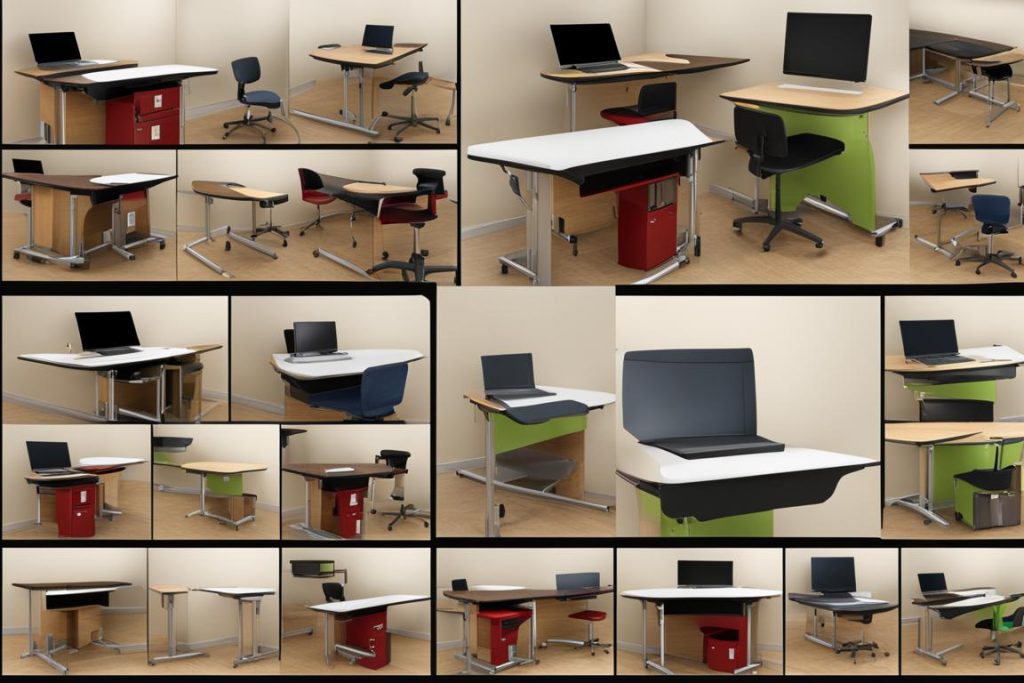Are you experiencing neck pain from sitting at your desk for long hours? You’re not alone. Many people suffer from neck pain due to poor desk ergonomics. Factors such as the type of chair, chair height, computer and monitor positioning, and lack of breaks can all contribute to neck pain while working at a desk.
But don’t worry, there are solutions to help prevent and relieve neck pain while working at your desk. By making a few adjustments and incorporating some healthy habits, you can significantly reduce discomfort and promote a pain-free work environment.
Why Does My Neck Hurt When Sitting at Desk
- Proper desk ergonomics can help prevent and alleviate neck pain.
- Adjust your chair height to support a neutral posture.
- Position your computer and monitors at eye level to reduce strain on your neck.
- Take regular breaks to stretch and relieve muscle tension.
- Consider using a standing desk or ergonomic chair for added support.
The Importance of Ergonomics in the Home Office
Ergonomics is a crucial aspect when it comes to creating a productive and comfortable work environment, even in the home office. While working from home offers flexibility, it also comes with its own set of challenges, especially when it comes to ergonomics. Neglecting proper ergonomics in the home office can result in back and neck pain, which can significantly affect productivity and overall well-being.
One common issue is the type of chair used in the home workstation. Many people opt for less ergonomic chairs, such as dining chairs or couches, which lack the necessary support for prolonged sitting. This can lead to poor posture and increased strain on the back and neck muscles.
Another common factor is the incorrect chair height, which can further exacerbate back and neck pain. If the chair is too high or too low, it can put unnecessary stress on the body. It is important to find a chair height that allows for proper alignment of the spine and supports a neutral posture.
The positioning of the computer and monitors also plays a significant role in ergonomics. Placing the monitor too low or too high can strain the neck and lead to discomfort. Similarly, improper keyboard placement can cause strain on the wrists and contribute to musculoskeletal issues.
Creating a home workstation that promotes proper ergonomics is crucial in preventing back and neck pain. Investing in an ergonomic chair that provides lumbar support and adjustable features can make a big difference. Adjusting the chair height to ensure that the feet are flat on the ground and the knees are at a 90-degree angle can help maintain proper posture.
Positioning the computer monitor at eye level, directly in front of the user, with the top of the screen at or slightly below eye level, can reduce strain on the neck and promote a more comfortable work posture. Using a separate keyboard and mouse, if possible, can also help maintain a neutral wrist position.


By prioritizing ergonomics in the home office environment, individuals can significantly reduce the risk of back and neck pain. A well-designed home workstation that accounts for proper chair support, correct height alignment, and optimal positioning of computer equipment can contribute to a healthier and more comfortable work-from-home experience.
Tips for Preventing Back and Neck Pain at the Desk
When it comes to preventing back and neck pain while sitting at a desk, there are several key tips to keep in mind. These strategies can help you maintain good posture, reduce muscle tension, and improve overall comfort throughout your workday.
1. Take Regular Breaks
One of the most important things you can do to prevent back and neck pain is to avoid prolonged periods of sitting without breaks. Sitting for extended periods can put strain on your muscles and joints, leading to discomfort and pain. Taking regular breaks, even if it’s just to stand up, stretch, or walk around, can help alleviate muscle tension and improve circulation.
2. Consider a Standing Desk
Using a standing desk can be a game-changer for preventing back and neck pain. Standing desks allow you to alternate between sitting and standing throughout the day, providing opportunities for changes in posture and relieving pressure on your spine. If possible, invest in a height-adjustable standing desk that allows you to easily switch between sitting and standing positions.


3. Choose an Ergonomic Chair
An ergonomic chair with adjustable features is instrumental in maintaining proper posture and reducing strain on your back and neck. Look for a chair that offers lumbar support, adjustable armrests, and a comfortable seat cushion. Making sure the chair is set at the right height can help you sit with your feet flat on the floor and your knees at a 90-degree angle, promoting a neutral spinal alignment.
4. Arrange Your Desk Ergonomically
Your desk setup plays a crucial role in preventing back and neck pain. Position your computer monitor at eye level, about an arm’s length away, to prevent straining your neck. Keep your keyboard and mouse at a height that allows your elbows to rest comfortably at a 90-degree angle. Consider using a keyboard tray or an adjustable monitor stand to achieve the optimal ergonomic arrangement for your desk.
5. Stretch and Strengthen Your Muscles
Incorporating simple stretching exercises throughout your workday can help alleviate muscle tension and reduce the risk of developing back and neck pain. Take a few minutes to stretch your neck, shoulders, and upper back regularly. Additionally, incorporating strength-building exercises, such as shoulder shrugs or back extensions, into your routine can help improve muscle endurance and support a healthy posture.
By implementing these tips for preventing back and neck pain, you can create a more ergonomic office environment and reduce the risk of discomfort and injury. Remember to listen to your body and make necessary adjustments to ensure you maintain a comfortable and pain-free work experience.
Addressing Tech Neck and Shoulder Pain
Spending long hours on electronic devices can contribute to neck and shoulder pain, commonly known as tech neck. Tech neck occurs when the muscles in the back of the neck have to work extra hard to hold up the head while looking down at a device. This can lead to symptoms like headaches, neck spasms, and stiffness.
To prevent tech neck, it’s important to practice good posture, take frequent breaks, and adjust the height of the device to eye level or slightly lower. By maintaining a neutral posture and avoiding the habit of holding the neck still in a forward position, you can reduce the strain on the neck and shoulders.
Engaging in regular aerobic exercise, such as walking or swimming, can also help alleviate tension in the neck and improve overall posture. Aerobic exercises work the large muscle groups and help strengthen the muscles that support the head and neck.
Remember to take breaks and stretch regularly when using electronic devices. A simple stretching routine that includes neck stretches, shoulder rolls, and chest openers can help relieve tension and promote better posture.
Adjusting Desk Height for Better Posture
The height of your desk is a critical factor in maintaining good posture and preventing musculoskeletal disorders. When your desk is too high, it can cause overworking of the shoulder and arm muscles, which can lead to tension and pain. Conversely, a desk that is too low can result in the need to hold your arms out, leading to static tension and posture issues.
To achieve a comfortable and neutral posture, it’s important to find the optimal desk height. A good starting point is to have your monitor at eye level, with your elbows bent at a 90-degree angle. This allows for proper alignment of the neck and shoulders. If your desk is not adjustable, consider using accessories like monitor risers or an adjustable keyboard tray to achieve the right height.
Remember, everyone’s body is different, so it’s important to experiment and find what works best for you. Here are some tips for finding the right ergonomic desk height:
- Start by adjusting the height of your chair. Your feet should be flat on the floor, with your knees bent at a 90-degree angle.
- When sitting at your desk, your arms should be relaxed and your shoulders should be in a neutral position. If they are raised or hunched, adjust the desk height accordingly.
- Avoid leaning forward or slouching while working. Maintain a straight back and engage your core muscles to support your posture.
- Consider using a footrest if your feet do not comfortably reach the ground.
- Take frequent breaks to stand up, stretch, and change positions. This can help alleviate muscle tension and further promote good posture.
- If you’re experiencing persistent pain or discomfort, consult with a professional ergonomics specialist or healthcare provider for personalized advice.
Adjustable Desks for the Win
If you have the option, investing in an adjustable desk can be a game-changer for your posture and overall comfort. An adjustable desk allows you to easily switch between sitting and standing positions, promoting movement and reducing the risk of developing musculoskeletal disorders. With the ability to fine-tune the desk height to your specific needs, you can optimize your workspace for better posture and greater productivity.
Conclusion
When it comes to finding relief from neck pain while sitting at a desk, implementing proper desk ergonomics is key. By making simple adjustments to your workstation, you can significantly reduce the risk of neck pain and improve your overall well-being.
Firstly, ensure that your chair is at the appropriate height to support a natural posture. Adjust the height of your chair so that your feet are flat on the floor and your knees are at a 90-degree angle. This will help alleviate strain on your neck and back.
Secondly, position your computer and monitors correctly. Your monitor should be at eye level, directly in front of you. Avoid excessive bending or straining of your neck by adjusting the screen height. Also, consider using an ergonomic chair with adjustable features, such as lumbar support and armrests, to further support proper posture and reduce strain.
Lastly, take regular breaks from sitting. Set reminders to get up and stretch or take short walks throughout the day. This helps prevent prolonged periods of sitting, promoting better circulation and reducing muscle tension in the neck and shoulders. If possible, incorporate a standing desk into your workspace for added flexibility and variety in your posture.
By following these tips and making adjustments to your desk setup, you can prevent and manage neck pain, improving your comfort and productivity while working at a desk. Remember to be mindful of your body and make changes as needed to maintain a pain-free work environment. Your well-being is important, and a few simple adjustments can go a long way in providing neck pain relief and enhancing your overall work experience.
FAQ
Why does my neck hurt when sitting at a desk?
Neck pain when sitting at a desk can be caused by poor desk ergonomics, such as an incorrect chair height, improper positioning of the computer and monitors, and not taking frequent breaks from sitting. These factors can strain the muscles and joints in the neck, leading to pain and discomfort.
How can I prevent neck pain from desk work?
To prevent neck pain from desk work, it’s important to prioritize proper desk ergonomics. This includes adjusting your chair height, positioning your computer and monitors correctly, and taking regular breaks to reduce prolonged periods of sitting. Using an ergonomic chair and considering a standing desk can also help prevent neck pain.
What exercises can I do for neck pain while sitting at a desk?
There are several exercises you can do for neck pain while sitting at a desk. These include neck stretches, shoulder rolls, and chin tucks. Performing these exercises regularly can help alleviate tension in the neck and improve flexibility.
How can I relieve neck pain while working at a desk?
To relieve neck pain while working at a desk, try adjusting your desk setup to promote proper posture and ergonomics. This includes setting the monitor at eye level, using an ergonomic chair with lumbar support, and practicing good posture. Taking regular breaks and engaging in aerobic exercise can also help relieve neck pain.
What are some tips for ergonomic desk height?
When it comes to desk height, it’s important to find a level that allows for a comfortable and neutral posture. Your monitor should be at eye level, and your elbows should be bent at a 90-degree angle. Consider using an adjustable desk or accessories to achieve the proper desk height and reduce strain on the neck and shoulders.
How can I prevent tech neck and shoulder pain?
To prevent tech neck and shoulder pain, practice good posture by holding your electronic devices at eye level or slightly below. Take frequent breaks to stretch and rest your neck and shoulders. Engaging in regular aerobic exercise can also help alleviate tension in the neck and improve overall posture.






